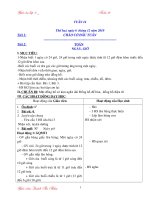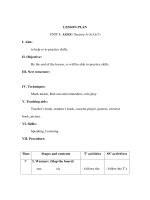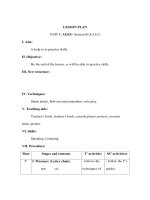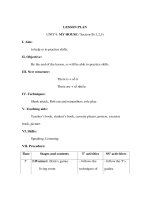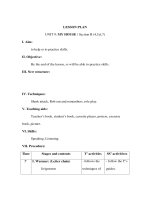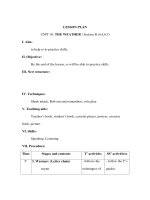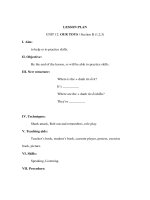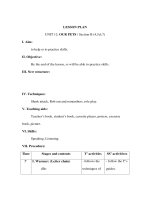- Trang chủ >>
- Mầm non - Tiểu học >>
- Lớp 2
Global Success_Grade 2_Lesson plan Review 2_ Giáo án review 2
Bạn đang xem bản rút gọn của tài liệu. Xem và tải ngay bản đầy đủ của tài liệu tại đây (66.87 KB, 12 trang )
TIẾNG ANH 2
LESSON PLAN
School:
Grade:
Teacher:
____________________
____________________
____________________
School year:
Week:
Approved by:
____________________
____________________
____________________
REVIEW 2
Phil and Sue – Period 1
Date: _______________
I. OBJECTIVES
II. INPUT
By the end of the lesson, pupils will be able to:
- repeat and understand a short story
- identify and say the words they have learnt
Language:
- Vocabulary: square, quiz, box, ox, juice, jelly, village, van
- Structures:
What’s he/ she doing? and He’s/ She’s _____ (verb + –
ing). to ask and answer questions about what someone is
doing.
Is there a/an _____? and Yes, there is./ No, there isn’t.
to ask and answer questions about whether or not
something is present.
Pass me the _____, please. and Here you are. to make and
respond to a request.
Can you draw a _____? and Yes, I can./ No, I can’t. to ask
and answer questions about ability.
Resources/Material:
- Student’s book, page 37
- Teacher’s guide, pp. 73 - 75
- hoclieu.vn
- Flashcards/Poster
- Computer, projector
1
III. PROCEDURE
Procedure
Warm-up
Warm-up – Listen and read – Look again and circle –
Wrap-up
Teaching and learning activities
Classroom
management
5 minutes
-
Remind pupils of the names of the topics Whole class
they have learnt from Unit 5 to Unit 8.
Option 1
- Refresh pupils’ memory of Units 5 to 8
topics by showing pictures of a classroom,
a farm, a kitchen and a village. Encourage
pupils to use the words and sentence
structures that they learnt.
- Say “Open your books at page 37 and look
at Review 2, Phil and Sue.”
Option 2
Group work
Have pupils play a game (e.g. Slap the board,
Pelmanism) with the words they have learnt in
the previous units.
Option 3
Group work
Stick some flashcards including some pictures
of the words from Unit 5 to Unit 8 on the
board. Write the words on the board. Have
pupils match.
1. Listen and read. 15 minutes
Step 1: Draw pupils’ attention to the pictures (say Whole class
“Look at the pictures.”). Ask questions to help
them identify the context.
Step 2: Have pupils point to Picture 1 (say “Point to Whole class
Picture 1.”). Play the recording for Picture 1
and encourage pupils to repeat (say “Listen
and repeat.”).
2
Step 3: Repeat Step 2 for Pictures 2, 3 and 4.
Whole class
Step 4: Play the recording of the whole story several Whole class
times and have pupils listen, point to the
speech bubbles and repeat until they feel
confident. Go around and offer help, if
necessary.
Step 5: Have pupils work in groups to act out the Group work
story. Go around the class to offer help and
correct pupils’ pronunciation, if necessary.
Step 6: Invite a few groups to act out the story for the Group work
class. Encourage them to use gestures, face
expressions, … Observe and support pupils
when needed.
Extension: For more advanced classes, have pupils close Individual work
their books and try to remember what the
characters are doing in each picture.
2. Look again and circle. 8 minutes
Step 1: Have pupils point to and say the word quiz Whole class
(say “Point to the word quiz. Say quiz.”).
Step 2: Have pupils look again at the story and try to Whole class/
find a quiz in one of the pictures (say “Look Individual work
again. Is there a quiz in the story?”). If there is
a quiz, pupils should circle the word/picture; if
not, then they do not need to circle the word/
picture.
Step 3: Ask pupils to look at the other pictures and Individual work
circle the words in the chain, saying “Use your
pencil to circle the words”. Give pupils time to
work. Give further support to those pupils
who find it difficult to do the task.
Step 4: Invite some pupils to show what they have Whole class/
done. Praise them if they have done well. Individual work
Have the class say all of the words they have
circled.
3
Answers: juice, jelly, village, ox
Wrap-up: 5 minutes
Revise the main teaching point of the lesson Whole class
by asking pupils some questions about the
story.
Option 1
Whole class
Using hoclieu.vn, show the pictures of the
story without showing the text. Have pupils
tell the story from their memory.
Option 2
Individual work
Show flashcards of the words that appear in
the story and have pupils say the words.
Option 3
Individual
Have pupils play Slap the board with the work/
words from Units 5-8.
Group work
4
TIẾNG ANH 2
LESSON PLAN
School:
Grade:
Teacher:
____________________
____________________
____________________
School year:
Week:
Approved by:
____________________
____________________
____________________
REVIEW 2
Self check – Period 2
Date: _______________
I. OBJECTIVES
By the end of the lesson, pupils will be able to:
- recognise the sounds they have learnt;
- recognise the words they have learnt;
- listen for specific sounds and words.
II. INPUT
Language:
- Sounds: Q/q (/k/), x (/ks/), J/j (/dʒ/), V/v (/v/)
- Vocabulary: question, square, quiz, box, fox, ox, juice, jelly,
jam, village, van, volleyball
Resources/Material:
- Student’s book, page 38
- Teacher’s guide, pp. 75 - 76
- hoclieu.vn
- Flashcards
- Computer, projector
5
III. PROCEDURE
Warm-up – Listen and tick – Listen and circle – Write and
say – Wrap-up
Procedure
Teaching and learning activities
Warm-up
5 minutes
Classroom
management
Option 1
Group work
Using hoclieu.vn, play the video of the story in
Lesson 1. Have pupils role play it.
Option 2
Whole class/
Show flashcards of the letters q, x, j and v. Group work
Have pupils say the letter names and the
letter sounds.
Option 3
Group work
Have pupils play Hot seat to revise the words
they learnt in previous units.
1. Listen and tick. 8 minutes
Step 1: Have pupils look at the pictures and say the
words (say “Point and say.”). When pupils
answer correctly, confirm by saying “jam/
jelly/ van/ volleyball/ square/ circle”.
Step 2: Play the recording and ask pupils to listen and
tick the correct box (say “Listen and tick”).
Give further support to those pupils who find
it difficult to do the task. Play the recording
again, if necessary (say “Listen again.”).
Step 3: Follow the same procedure with the pictures
of questions 2 and 3. Go around and offer
help, if necessary.
Step 4: Check the answers by asking “a or b?”. When
pupils answer correctly, confirm by saying
“1a. jam”/“2b. volleyball”/“3a. square” and
encourage them to repeat.
Audio script: 1. jam 2. volleyball 3. square
6
Whole class/
Individual work
Whole class/
Individual work
Whole class/
Individual work
Whole class
Extension:
Answers: 1. a 2. b 3. a
Put the flashcards of Units 1-4 at different Group work
places in the class. Have pupils play in groups
of four. Say one word, for example, van, the
pupils will try to run to the flashcard “van” as
fast as he/she could to slap on the word.
2. Listen and circle. 7 minutes
Step 1: Have pupils look at the pairs of letters and say Whole class
the letter sounds in pairs (say “Point and
say.”). Invite some pupils to say the letters
and the sounds in front of the class.
Step 2: Play the recording, ask pupils to listen and Individual work
circle the letters of the sounds (say “Listen
and circle.”). Allow pupils time to complete
the activity. Play the recording again, if
necessary (say “Listen again.”).
Step 3: Check the answer to Question 1 by asking “/k/
or/v/?” Invite some pupils to say the sounds
they have heard. When pupils answer
correctly, confirm by saying “/k/.” and
encourage them to repeat.
Step 4: Repeat Step 3 for Questions 2, 3 and 4.
Individual work
Individual work
Audio script: 1. q 2. j 3. x 4. v
Extension: Divide pupils into groups. Have them listen to
one sound, for example /v/, and in one
minute, pupils try to find out the words
containing the sound /v/ such as van,
village, ... The group with the most correct
words wins.
3. Write and say. 10 minutes
Step 1: Draw pupils’ attention to Picture 1, say “Look Whole class
at Picture 1”. Have pupils point and say the
words (say “Point and say.”). When pupils
answer correctly, confirm by saying “fox/
question/ juice/ village”.
7
Step 2: Have pupils write the letters to complete the Individual work
words (say “Look and write.”). Allow pupils
time to complete the activity. Go around the
class to offer support.
Step 3: Get pupils to check their answers in pairs. Pair work
Then ask some pairs to give their answers.
Give comments and confirm the correct
answers.
Step 4: Have pupils say the words (say “Now say.”)
Whole class
Write incomplete words on the board and Individual work
Extension:
have some pupils write letters to complete
them.
E.g: _ an , _ am, _uice, _bo_ , …
Wrap–up
5 minutes
Option 1
Whole class
Have pupils play Kim’s game. Stick flashcards
on the board. Have pupils look at the cards for
30 seconds. Then ask them to close their eyes.
Have them open their eyes again and say
what words have been missing.
Option 2
Group work/
Stick some picture cards on the board. Write Individual work
the words on the board. Have pupils match.
Option 3
Individual work
Have pupils play Pass the ball game. Give
flashcards for pupils to pass with the music,
then when the music stops, those who get the
flashcards will say the words.
8
TIẾNG ANH 2
LESSON PLAN
School:
Grade:
Teacher:
____________________
____________________
____________________
School year:
Week:
Approved by:
____________________
____________________
____________________
REVIEW 2
Self check – Period 3
Date: _______________
I. OBJECTIVES
By the end of the lesson, pupils will be able to:
– recognize the target words and sentence structures;
– write the learnt words.
II. INPUT
Language:
- Vocabulary: question, square, quiz, box, fox, ox, juice, jelly,
jam, village, van, volleyball
- Structures:
What’s he/she doing? and He’s/She’s _____ (verb + –ing).
to ask and answer questions about what someone is doing.
Is there a/an _____? and Yes, there is./No, there isn’t. to
ask and answer questions about whether or not something
is present.
Pass me the _____, please. and Here you are. to make and
respond to a request.
Can you draw a _____? and Yes, I can./ No, I can’t. to ask
and answer questions about ability.
Resources/Material:
- Student’s book, page 39
- hoclieu.vn
- Teacher’s guide, pp. 76 - 77
- Flashcards
- Computer, projector
9
III. PROCEDURE Warm-up – Read and tick – Find the words – Write the
words – Wrap-up
Procedure
Warm-up
Teaching and learning activities
Classroom
management
5 minutes
Option 1
Whole class
- Have pupils sing one or two songs from Units 5
- 8 to revise the words and structures they have
learnt. If pupils do not remember the songs, play
the recording for them to sing along.
Option 2
Whole class/
Show pupils the lyrics of a chant or a song from
Individual
Units 5 - 8 with some missing words, e.g.:
work
Is there a fox? Is there a __?
Yes, there is. Yes, there is.
There’s a __ in the box.
Is there an ox? Is there an ___?
No, there isn’t. No, there isn’t.
There isn’t an ___on the farm.
Then ask pupils to listen to the chant/song and
fill in the blanks, then sing the complete
chant/song aloud.
Option 3
Group work
Have pupils play the game Mystery bag to revise
the sounds and words they learnt in previous
units.
4. Read and tick. 8 minutes
Step 1: Have pupils read and say the sentence Whole class
structures in Question 1 Is there a box? Yes,
there is. (say “Read and say.”)
Step 2: Have pupils look at the pictures underneath the Whole class
sentence structure (saying “Look at the pictures
in Question 1, please!") and say what they can
see. When pupils answer correctly, confirm by
saying “box/ book”.
10
Have pupils read the sentence structures and
tick the correct box (say “Read and tick.”). Allow
pupils time to complete the activity. Give further
support to those pupils who find it difficult to do
the task.
Step 4: Check answers by saying “a. or b.?” When pupils
answer correctly, confirm by saying “a.” and
encourage them to repeat the question and
answer.
Step 5: Repeat Steps 1 to 4 for the sentence structures
in Questions 2 and 3.
Step 3:
Individual
work
Whole class
Whole class/
Individual
work
Extension: Say aloud some sentences and have pupils slap Group work
the suitable pictures.
5. Find the words. 8 minutes
Step 1: Draw pupils’ attention to the word search and
the list of eight words. Have them point to and
say each word (say “Point and say.”)
Step 2: Ask pupils to look at the word search, find and
circle the words in it individually. Allow pupils
time to complete the activity.
Step 3: Check answers by showing the word search grid
on the board and inviting pupils to come to the
front and circle the words.
Extension: Ask some advanced pupils to make sentences
with these words.
Extension: Have pupils rearrange the sentences to make
meaningful sentences. E.g:
the sail / I / can see (I can see the sail.)
flying/ He’s/ a kite (He’s flying a kite.)
Whole class
Individual
work
Whole class
6. Write the words. 8 minutes
Step 1: Have pupils look at and describe the picture Whole class
using the words they have learnt.
Step 2: Write v _ _ _ _ _ _ on the board and encourage Whole class
pupils to complete the word. When they answer
correctly, confirm by saying “village” and
11
encourage them to repeat.
Step 3: Repeat Step 2 for square (s _ _ _ _ _), box (b _
_), juice (j _ _ _ _), jelly (j _ _ _ _) and volleyball
(v _ _ _ _ _ _ _ _ _).
Step 4: Say “Write the words.” and allow pupils time to
complete the activity.
Step 5: Check answers by inviting pupils to come to the
front and complete the words village, square,
box, juice, jelly and volleyball on the board.
Extension: Show the picture of some learnt words and ask
pupils to write the words on their notebooks.
Ask pupils to swap their answers with other
classmates. Then check the answers as a class.
Wrap–up
Whole class
Individual
work
Individual
work
Whole class/
Individual
work
5 minutes
Option 1: Have pupils play Pass the ball game. Whole class
Give flashcards for pupils to pass with the music,
then when the music stops, those who get the
flashcards will say the words.
Option 2: Show flashcards and have pupils say Individual
the words. Ask some pupils to make sentences work
with the words.
Option 3: Write incomplete sentences on the Individual
board (with pictures). Invite some pupils to go to work
the board and write the letters to complete the
sentences.
E.g. The picture of the jam and the text: Pass me
the _____, please.
12
